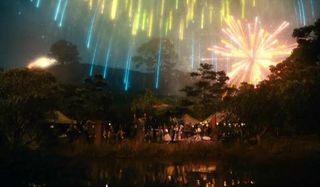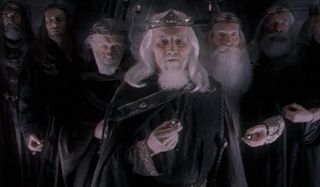5 Hobbit Extended Editions Scenes That Actually Make The Movies Better

Peter Jackson’s Hobbit series is over. It took three long years, but last December the New Zealand-born filmmaker released the final chapter in his cinematic vision of author J.R.R. Tolkien’s Middle-earth. But while you may have seen all of the movies released so far, you actually haven’t seen the full story just yet, as we are only now about to see the world premiere of The Hobbit: The Battle of the Five Armies Extended Edition.
To celebrate the upcoming digital and Blu-ray release of the epic fantasy film, Fathom Events is hosting a special big screen presentation tonight of the longer version of the Hobbit’s final chapter. In anticipation of this special event, we went back to look at the Extended Editions of both An Unexpected Journey and The Desolation of Smaug to look for key scenes that were removed from the theatrical version of the movies but still actually add quite a lot. What are these scenes? Read on and find out!

Young Bilbo Enjoying Gandalf’s Fireworks
"Show Don’t Tell" is an important philosophy in the movie world. After all, it’s a visual medium, and an audience is going to be bored to tears if everything is just explained to them through either narration or exposition-heavy dialogue. It’s for this reason that I give a lot of credit to a very quick scene at the start of The Hobbit: An Unexpected Journey, featuring Gandalf setting off fireworks with a young Bilbo Baggins by his side.
This moment doesn’t have a giant impact on The Hobbit trilogy as a whole, but it is a pretty and fun little moment that does a good job enhancing what are at the end of the day multiple references to Gandalf’s fireworks. It is a bit weird that we never get to see the wizard’s face – presumably because the production didn’t want to shell out the money to de-age Ian McKellen – but it’s such a nice and small moment that I wonder why Peter Jackson decided to cut it out.

The Extra Songs
The songs in The Hobbit: An Unexpected Journey get a bit of hate of casual movie-goers, as they do have a part in slowing down the first act of the film, but the truth is that the music is an element that any real Tolkien fan should be able to appreciate. After all, the lyrics that the characters sing come directly from the book, and a director who cares much less about the source material would have axed them completely. That on the table, there’s a lot to like about the two extra songs sung in the extended version of the movie.
CINEMABLEND NEWSLETTER
Your Daily Blend of Entertainment News
There are actually two musical numbers that were ultimately left out of the Unexpected Journey theatrical cut – one with Bofur singing a tune while eating dinner in Rivendell, and the second sung by the Goblin King after capturing the dwarves – and while both are rather goofy, they make the earlier songs feel less out of place and also really capture a larger spirit of Tolkien’s book (even if the Bofur bit was a song from "Lord of the Rings").

Kili Shows An Early Attraction To Elves
There are multiple tiny moments in both An Unexpected Journey and The Desolation of Smaug’s extended cuts that help shine a light on the individuality of the dwarfs – something of which the theatrical versions could have used more – but my favorite amongst them is in the first movie when the dwarves are having a feast in Rivendell. Kili shares glances with an Elf harp player, and when caught by Dwalin has to explain that he’s never actually been attracted to elf maidens. He makes exception to one that walks behind him… only to discover that it’s no maiden.
In addition to being a funny little moment that just makes fun of the feminine looks of male elves, this winds up being a nice bit of foreshadowing that ultimately enhances the nine-hour experience of watching the entire trilogy. Kili, of course, winds up forming a close relationship with Evangeline Lilly’s Tauriel, and while it’s not from the books, it does actually add some real emotion to The Hobbit: The Battle of the Five Armies.

What Happened To Thrain?
The theatrical versions of The Hobbit: An Unexpected Journey and The Desolation of Smaug do a good-yet-unfortunate job of answering the question of what happened to Thorin’s grandfather, Thrór – revealing that Azog cut his head off in the battle of Moria – but there is one thread that’s left untied: what happened to Thorin’s dad, Thrain? The versions of the Hobbit movies that most people have seen don’t answer this question, but the extended version of The Desolation of Smaug does so in an interesting way.
An extended scene at the beginning of the movie, Thorin and Gandalf discuss that Thrain was killed during the battle of Moria, but it’s later in the movie that we learn he is both still kicking and completely out of his mind. It turns out he was captured at Moria, brought to Dol Guldur, and from what I can tell tortured until driven mad. It’s sad that he’s killed almost as quickly as he is introduced, taken down by the Necromancer, but it’s still a nice part of the larger story to have.

So That’s Where That Ring Went…
More than just answering the question of what happened to Thrór, the extended versions of both An Unexpected Journey and The Desolation of Smaug also feature an thread that links the entire trilogy to the events in The Lord of the Rings movies. In the longer cut of the first film, a discussion about the last of the seven rings that were given to the Dwarf-lords is started by Gandalf when meeting with Galadriel and Elrond, and Saruman shoots him down by saying that the One Ring is the only one that actually matters. This turns out to be a set up for Thrain’s reintroduction in the second movie, as it’s revealed that Azog cut his ring right off his finger, and has been using its power for himself.
This is not only a solid connection made between the first two films, but also is in general a nice original plot thread not featured in Tolkien’s book (having written "The Hobbit" before imagining "The Lord of the Rings," the author couldn’t exactly have crafted those connections). This is also a part of the story that can easily be continued in The Hobbit: The Battle of the Five Armies Extended Edition, so we’ll be keeping an ear perked for references to it.

Eric Eisenberg is the Assistant Managing Editor at CinemaBlend. After graduating Boston University and earning a bachelor’s degree in journalism, he took a part-time job as a staff writer for CinemaBlend, and after six months was offered the opportunity to move to Los Angeles and take on a newly created West Coast Editor position. Over a decade later, he's continuing to advance his interests and expertise. In addition to conducting filmmaker interviews and contributing to the news and feature content of the site, Eric also oversees the Movie Reviews section, writes the the weekend box office report (published Sundays), and is the site's resident Stephen King expert. He has two King-related columns.
Most Popular



